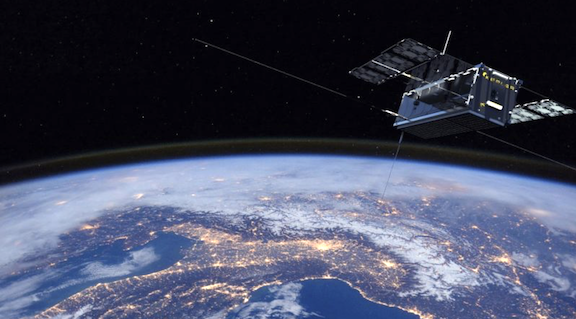
An artistic view of Kipp, Kepler’s first Ku-band LEO satellite.
Photo Credit: Kepler

Two companies have partnered to combine their assets offering a dynamic service. The companies and their new service was announced to eliminate barriers to widespread adoption of high capacity data services over Kepler Communication’s Low Earth Orbit (LEO) network.

Kepler Communications and Cobham SATCOM's new partnership translates that under the new arrangement, organizations that evaluate Kepler’s ability to cost-effectively move multiple gigabytes of data per day around the globe can experience a fully managed trial of the service anywhere with no upfront CAPEX spend, no lengthy service commitment, and certified installation and support executed through Cobham SATCOM’s global Technical Service Partner network.
The ‘User Terminal-as-a-Service’ (UTaaS), the Kepler-Cobham partnership centers on three core principles:
- shifting equipment costs to a monthly operational fee from a more traditional one-time capital expense
- embedding installation, technical support, terminal maintenance, warehousing, and transport services into the monthly fees with future capabilities for add-on services
- exchanging technical know-how to improve the delivery of LEO wideband services going forward.

To further validate the effectiveness of the new UTaaS partnership, recently the two firms confirmed that Cobham’s full range of SAILOR and Sea Tel antenna systems, used in the maritime communications segment, are both fully capable of tracking LEO satellites on land and at sea.
As an example, Kepler and Cobham successfully deployed their system recently utilizing two augmented Sea Tel antennas aboard the Polarstern research vessel. Currently, the network is delivering services in the central Arctic well beyond the range of traditional geostationary satellites and has demonstrated up to 40 Mbps downlink and 120 Mbps uplink.
Kepler’s Global Data Service (GDS), which is currently enabled by Kepler’s first two satellites in orbit, is a high-capacity worldwide data communication service that enables the movement of Gigabytes of data to and from the user’s location at economic rates. The store-and-forward nature of the solution makes it suitable for delay-tolerable data such as large multimedia files, high-resolution videos and imagery, and other bandwidth-intensive data within the maritime, oil & gas, tourism, and scientific communities.
Jeffrey Osborne, Co-founder and VP of Business Development at Kepler and Matt Galston, Sr. Director Global Market Strategy and Development, Cobham SATCOM concluded with comments that include;
Jeffrey Osborne, Co-founder and VP of Business Development at Kepler said that proven, reliable ground segment is a critical piece for delivering wideband services from LEO. The cost of today’s tracking antennas as well as the complexity of coordinating setup, installation, and support are understandable roadblocks for those wishing to test drive their Global Data Service. At Kepler, their goal is to deliver the most frictionless customer experience possible so that anyone with a potential use case for this groundbreaking capability can simply say ‘yes’ and keep their focus on the really important elements of their application. Their partnership with Cobham enables them to create precisely that experience where they can scaleably execute demonstrations anywhere on the planet all for a manageable monthly OPEX fee that includes hardware, setup, support, and airtime.
Matt Galston, Sr. Director Global Market Strategy & Development, Cobham SATCOM commented that Kepler’s approach is unique for their industry. By starting with a small number of satellites in operation, they focus more directly on solving problems for the end-user. Their collaboration demonstrates how some solutions come through partnerships, new commercial models, and a shared goal of delighting end-users while being able to scale that delight to many more in time. It’s exciting to be a part of this journey, and they are confident Kepler’s future is very bright.

For all involved in the satellite and space industry and the various market segments that enhance these dynamic environments, the 2020 SmallSat Symposium is invaluable.
The 2020 SmallSat Symposium begins on February 3, 2020, with workshops on the first day. Then the Conference continues from February 4 to 6 at the Computer History Museum in Mountain View, California, in the heart of Silicon Valley.

The SmallSat Symposium is hosted by Satnews Publishers which, since 1983, has been a provider of satellite news, media and events. This information packed forum enables you and your company to secure a larger portion of market share as well as to take a step into the next stage of your company's, or organization's, growth.
The personal connections at the SmallSat Symposium enable attendees to network with established organizations, subject-matter experts as well as 'New Space' entrants.
The SmallSat Symposium will focus on the daily changes in new technologies and the business environment that is shaping the implementation of SmallSat constellations, SmallSat launchers, the challenges facing the SmallSat developer and actors as well as the enormous benefits of these advanced technologies that will benefit our world.
This event attracts more than 100 diverse speakers, all of whom possess deep industry experience. Additionally, numerous opportunities exist to mingle and network with peers while enjoying exceptional, complimentary meals and refreshment breakfast.

